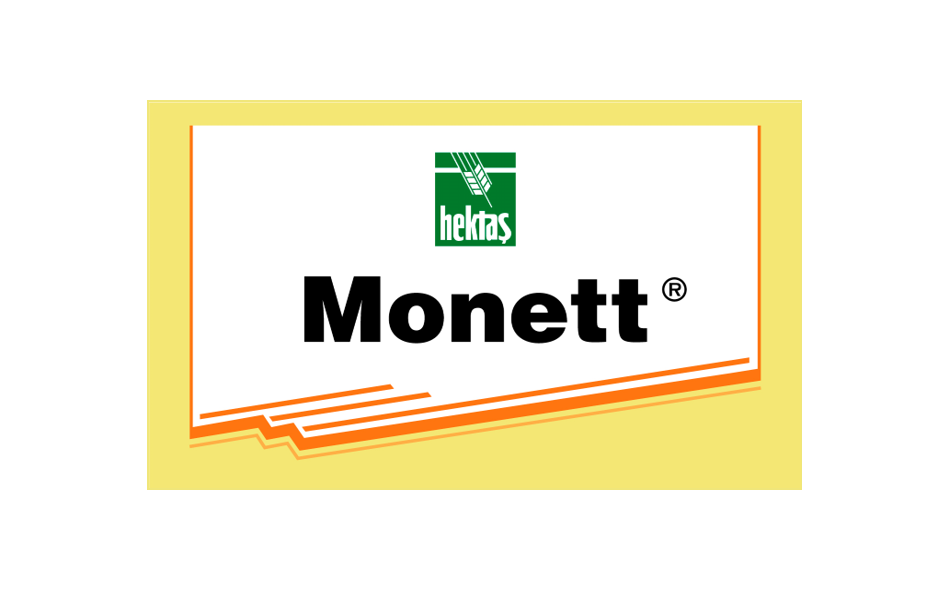Description
Specifications
MONETT is a selective systemic herbicide used post-emergence against broad- and narrow-leaved weeds in corn fields. MONETT is absorbed primarily by offshoot leaves and roots, carried by the plant’s transport tissues (phloem and xylem) and stops growth immediately after application. One of the pesticide’s active substances, mesotrione directly inhibits carotenoid biosynthesis in weeds, destroying chlorophyll and killing the weeds. Nicosulfuron is an active substance of the sulfonylurea group and an inhibitor of ALS enzyme synthesis. This enzyme is required for the making of essential protein blocks, valine and isoleucine. Growth and activities of weeds rapidly come to an end as a result of this inhibition. First effects of spraying are noticed within a week and all weeds die in 15-20 days. Monett is a weed medicine that can only be used in corn. When used in accordance with the recommendations, it is well tolerated by corn. It is not recommended to be used in corn fields sown for seed production. It is not used in the varieties of sweet corn and popcorn. If there is no emergence of corn for any reason, corn can be planted again immediately. As a cropping plant, winter wheat and barley can be planted after tillage. CAUTION: Sugar beet, peas, broad bean sowing can be done 18 months after Monett administration and after tillage. Following corn sowing, sugar beet and vegetables as a cropping plant
Method of Application
Time of Application: Corn should be in 1-8 true-leaf stage during spraying. In post-emergence applications, weak cuticle development in corn, weak soil structure or a slight discoloration in the corn plant in cold, moist or dry weather conditions can be observed. However, such changes are temporary and don’t cause any yield loss. Sprayings shouldn’t be done during warm hours. There shouldn’t be any precipitation in 4-5 hours after spraying. A thorough spray-coating is necessary for good weed control.
Other Informations
Compatibility:
Monett shouldn’t be used in combination with other sulfonylurea compounds as a tank mixture and consecutive applications with such compounds should be avoided. Since phytotoxicity may develop in corn, it shouldn’t be used within the same year as organic phosphorous soil insecticides. Monett shouldn’t be used for 7 days following foliar application of an organic phosphorus insecticide in corn. Do not mix with foliar fertilizers and liquid fertilizers. It is not necessary to mix with other pesticides for use.
Detailed Table Information
| Name of the product | Plant Name | Weed Name | Usage dose |
|---|---|---|---|
| Monett | Corn |
Okra (Hibiscus trionum)
|
300 ml / da after emergence, weeds in the period of 2-6 leaves |
| Monett | Corn |
Field bindweed (Convolvulus arvensis)
|
300 ml / da after emergence, weeds in the period of 2-6 leaves |
| Monett | Corn |
Lamb’s quarters (Chenopodium album)
|
200 ml / da after emergence, weeds in the period of 2-6 leaves |
| Monett | Corn |
Common nightshade (Solanum nigrum)
|
300 ml / da after emergence, weeds in the period of 2-6 leaves |
| Monett | Corn |
Red-root amaranth (Amaranthus retroflexus)
|
200 ml / da after emergence, weeds in the period of 2-6 leaves |
| Monett | Corn |
Johnson grass (Sorghum halepense)
|
250 ml / da after emergence, weeds in the period of 2-6 leaves |
| Monett | Corn |
Velvetleaf (Abutilon theophrasti)
|
200 ml / da after emergence, weeds in the period of 2-6 leaves |
| Monett | Corn |
Common cocklebur (Xanthium strumarium)
|
200 ml / da after emergence, weeds in the period of 2-6 leaves |
| Monett | Corn |
Awnless barnyard grass (Echinochloa colona)
|
200 ml / da after emergence, weeds in the period of 2-6 leaves |

